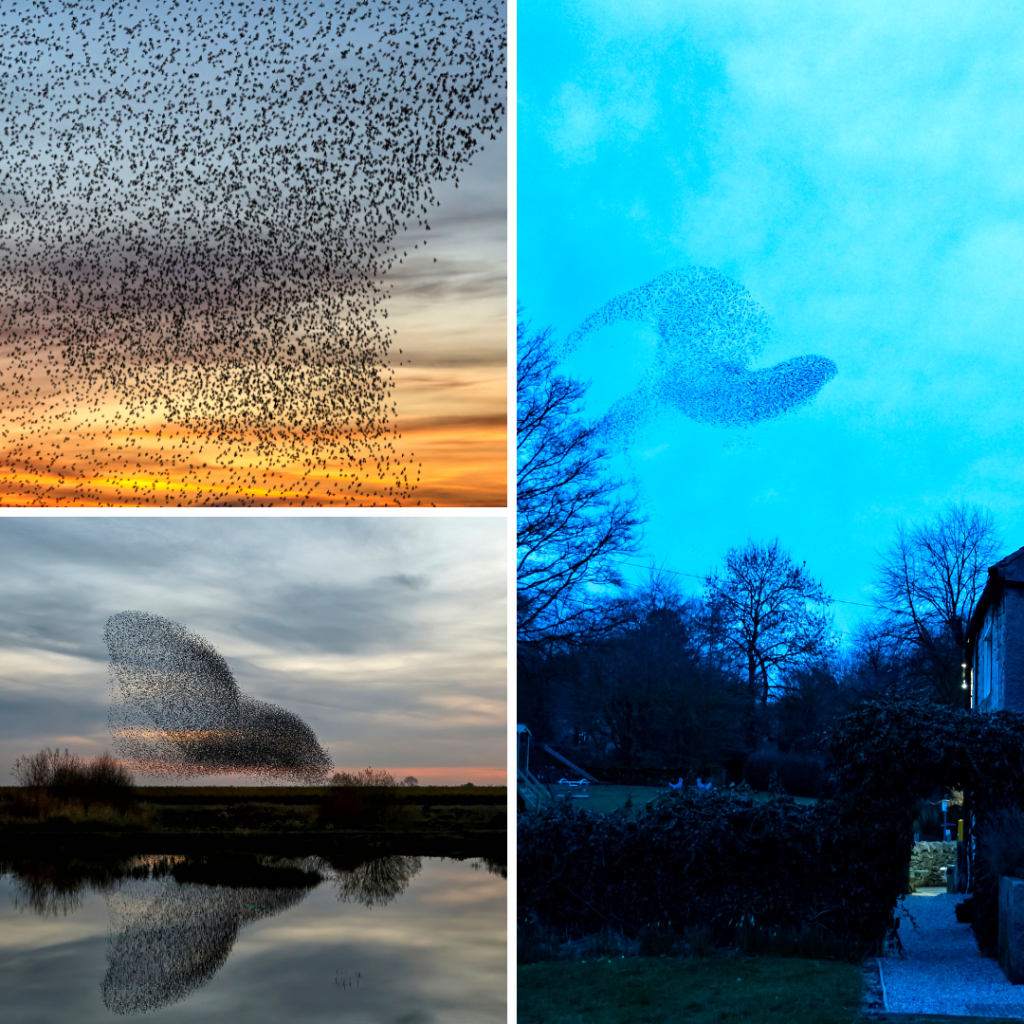Murmuration: Starlings’ Fascinating Sky Dance

For me, birds are the harbinger of the seasons — the first robin of spring, the first hummingbird of summer, the first dark-eyed junco (some call them snowbirds) of early winter.
But there is one more that isn’t a single bird, it is the amazing ballet of starlings, flying en masse, in hundreds, sometimes thousands, of birds, shapeshifting as they go, looking like fast-moving black clouds that create art in the air from November through February. This is murmuration.
At first, when I learned the name for this incredible phenomenon, I thought it sounded more like ol’ Uncle Joe who was always murmuring some negative comments under his breath. Murmuration … sounds right, doesn’t it?
But the word murmuration comes from Medieval Latin, murmuratio, meaning to grumble or murmur. The thought was the name was inspired by the sounds of those hundreds of flapping wings sounding like a murmur. However it got its name, it is a fascinating phenomenon of nature.
Every time I have a chance to witness these amazing birds fly up in unison and start twirling and whirling as if they were one organism, my science nerd brain has so many questions. Why do birds do this? Is it only starlings? How do they do it?
How do they know when to do it? Is there a leader who orchestrates the moves? Do they all get a group text, or practice at night like people who gather to do those flashmob dances at the mall? Fortunately, science has studied this interesting group flying dance and has proposed some answers.
So, let’s start with the basics: Are starlings the only animals that do this? Actually, no. Chimney swifts, red-winged blackbirds and common grackles are also known to form these collective flight patterns. And then there are fish, usually tiny fish, that swim together. The term used for that collective swim pattern is schooling or shoaling.
Even though there are different terms for it in the sky and under the sea, there have been numerous suppositions — both folklore and serious scientific analysis have tried to answer why this phenomenon occurs.
In the 1930s, the famed British bird expert (ornithologist), Edmond Seleous, proposed that the behavior was via mental telepathy, although no reports of little foil hats on the birds were ever found. Kidding, about the foil hats; not the proposition of mental telepathy.
But seriously, animal behaviorist scientists have done numerous studies on murmuration. Much of the original studies were done using high-resolution photographs of individual murmurations; now computer modelling has allowed even more detailed investigation.
Scientists have similar conclusions as to the why: to avoid predation by larger animals. When these collective flights or swims are occurring, the image to the predators of these animals, appears to be a larger singular animal, instead of the smaller individual animals they actually are.
The shifting, large cloud of birds confuses predators. This fits the old adage “strength in numbers.” Most folklore sayings have kernels of truth in them.
From an engineering standpoint, murmuration helps most of the birds of the group fly easier. There is a collective aerodynamic lift that murmuration creates. When a bird flaps its wings, it creates air vortices that creates lift that make it easier for the birds behind it to fly. This benefit of ease of flight is also seen in the V-shape of Canada geese.
In Canada geese, the V-formation is thought to make it easier to fly. Did you know the lead birds take turns? They do. When the lead bird tires, they rotate to farther back in the V, and another bird takes their place.
Even more amazing, I was fascinated to learn the V-formation of Canada Geese also allows the birds behind the leader to be literally half awake in flight. Geese in the V-formation can sleep using unhemispheric sleep. This means that one side of their brain can actually turn off (and rest), while the other half remains alert for the flight and on alert for any predators.
But what about the “how” of murmuration? Compared to the simple V-formation of Canada geese, how do the thousands in a murmuration organize? Researchers found that each bird in the murmuration monitor the movements of seven birds that surround them, and this guides the mass movements.
Each individual bird uses three zones: attraction, repulsion and angular alignment to coordinate their flight within the group. The attraction zone is forward — each bird moves forward toward the bird in front of them.
The repulsion zone is where the bird avoids the same “lanes” as the birds around them. And the angular alignment is the exact location maintained by each bird as it focuses on those seven birds directly around them. And we thought the construction lanes on I-80 were confusing?
No discussion of starlings is complete with the issue of why they are, by many, considered negative. Yes, their populations are huge. Yes, they are non-native birds (which many other birds are as well). Yes, they can cause problems in the agricultural field and the backyard bird feeder area, too. But did you know that when you see them on your lawn pecking away at something in the turf, they are also a great organic control for turf pests, particularly fall armyworm? No need to apply pesticide when the starlings are at work.
Everything in nature has a purpose. And we are still trying to understand it all.
